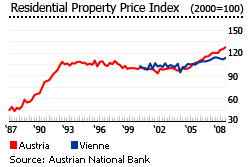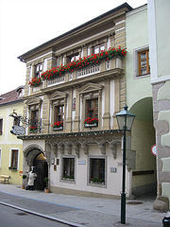Vienna strong, while Austria slips

House prices rose in Vienna during the first 9 months of 2008, while prices for the rest of Austria started to slip.
The Vienna residential property price index rose 6.3% (2.5% in real terms) during the year to end-Q3 2008. It rose by 6.2% in 2005, 7.6% in 2006 and 5.7% in 2007.
The index for the ‘rest of Austria’ fell 0.8% during the year to end-Q3 2008 (a 4.3% drop in inflation-adjusted terms). This compares with house price rises of 4.9% in 2005, 3.15% in 2006 and 3.7% in 2007.
Vienna’s price growth is unchanged – while the rest of Austria is weakening, having seen two negative quarters.
Austria saw a dramatic rise in dwellings prices during the period 1987-1994, when Vienna prices rose by almost 150%, following positive developments in Eastern Europe, increased immigration, and the expansion of owner occupancy. In some suburbs prices even tripled.
However, the price rises ended when the immigration inflow ended, optimism waned, and when extra housing supply came into the market. By 2001, property prices in Vienna were 14% lower than their 1994 level.

The house price boom after 2005 was mainly due to low interest rates, mortgage market expansion and strong economic growth.
However, Austria’s economy is expected to contract by as much as 2% in 2009. Therefore the housing market is likely to stagnate, with prices frozen in Vienna, and falling for the rest of Austria.
Even though a minor economic recovery is anticipated in 2010 (GDP growth of about 0.5% is expected), dramatic house price rises in Austria are highly unlikely, due to economic, social and institutional conditions.
Resilient Vienna

The resilience of Vienna compared with the rest of the country is partly due to the unusual ownership pattern in the city centre. Institutional investors, banks and companies own around 70% of residential real estate in Vienna’s city centre, according to Colliers Austria Market Report 2008. Hence, they are in a better position to hold on to their property during times of economic slowdown or crisis.
The same report also notes in the first district, the heart and historical centre of Vienna, prices have doubled within a decade, from €5,000 per sq. m. in 1997 to €13,000 per sq. m. in 2007 for newly built penthouses. On the other hand, prices of refurbished units in turn of the century buildings were around €10,000 per sq. m.
These strong price rises were due to a combination of strong demand, and little or no new supply. There has been strong growth in demand for larger units (100 sq. m. and up) in the city centre. With the limited supply of large units, prices of such apartments rose faster than smaller-sized units.
Dwellings supply
More Global Property Guide pages: |
The number of new dwellings built in Austria fell to about 40,000 units a year during 2001-2004, from around 66,000 units yearly in the 1990s. Recent figures are not available, due to technical issues and legislative delays. Nevertheless, the dwelling stock microcensus suggests a drop in dwelling completions.
There were 3,536,900 primary residences in 2007, up from 3,315,347 in 2001. So during these six years, the stock of primary residences rose by only 221,553, or 36,925 units a year.

In Vienna, the stock rose by 8,760 units a year (2001 to 2007), from 770,955 in 2001 to 823,500 in 2007. This is a reduction in dwelling completions, from an average 10,800 annually 1995-2001.
A similar drop in dwelling completions took place in Austria’s three other most populous states: Lower Austria (which surrounds Vienna), Upper Austria, and Styria.
Variable rate loans
Most loans to households in Austria are variable rates, not fixed, though the ratio changes as interest rates fluctuate.
For instance, 70% of new loans in 2000 were variable rates, while the remaining 30% were fixed. The percentage of variable rate new consumer loans rose to 90% in Q3 2006, before falling back to 54% as of Q4 2008.
Most housing loans also tend to be a variable rate, though again the proportions fluctuate. A 2008 central bank survey suggest that around 67.1% of households with housing loans have variable rate loans, while only 38.5% have fixed rate loans. The remaining 6.4% pay no interest, i.e., have borrowed from family members or friends.

The Austrian housing market is therefore quite sensitive to interest rate changes.
Following the drop in European Central Bank key rates, the variable housing loan interest rate dropped to around 4% - 4.5% from 2003 to 2006. Since then, rates have moved up, and then slightly down again, to 5.63% in December 2008.
Small mortgage market
Austria’s mortgage market is small compared to other EU countries. Outstanding housing loans rose from €29 billion in 2001, to €71.35 billion in 2008; or from 14% of GDP in 2001 to 25% of GDP in 2008. The average mortgage market size in the EU is 50% of GDP.

Mortgage growth was accompanied by an increase in foreign-currency denominated loans from around 27% of total housing loans in 2002, to 38% in 2006 and 2008 (the ratio dipped to 34% in 2007). Most foreign currency loans are Swiss franc-denominated (95.3% of all forex loans in 2008). Most have variable interest rates.
Rental market
Vienna has one of the highest percentages of renter households in the world, at 77.2% in 2007, while the figure for Austria as a whole is around 58%. Around half of the rental stock in Vienna and Austria is privately owned.
Rising purchase prices and static rents have led to very low rental yields in Vienna. An oversupply of rental units during the 1990s led to a fall in rents. The rent decline stopped in 2000 and rents even rose briefly until 2001, but fell once more in 2002.
No rent increases took place in Vienna in 2007 and none can be expected in the near future, according to a recent Colliers report. Monthly rents for the most luxurious apartments in the city centre were a generous €22 per sq. m. in 2008, but the report adds that most apartments earned monthly rents of only between €7 and €12 per sq. m., due to legal restrictions.

The result is weak yields. Top city centre apartments produced net rental returns of no more than 1%, according to Colliers, while net rental yields for the rest of the city were around 2% to 4%. This estimate contrasts with Global Property Guide’s own research, which suggested gross rental yields of 4.3% to 6%. However there is a significant difference in methodology, in that the Colliers figures are net, while the Global Property Guide figures are gross, and therefore inevitably higher.
Austria’s rental market is segmented via tenure, regulation and market forces into a hierarchy of low rents for municipal, other social tenants and long-term incumbents in the private sector, but higher free market rents for recent entrants into the private rental sector.
Economic decline
Austria economic growth strengthened between 2004 and 2007 (average annual growth of 2.96%), after a weak start to the century (Austria experienced average annual growth of 0.99% from 2001 to 2003).

The stronger economy was mainly due to one sector, exports, to one country, Germany. More than 75% of Austria’s exports go to Europe, 30% to Germany. Exports of goods and industry grew by 7.3% in 2006 and 8.4% in 2007. Germany, in turn, exports mainly to France, US, UK and other EU member countries.
Austria’s economy has suffered from the economic recessions in its export markets, but with a lag. After marginal economic growth in the first two quarters of 2008 (0.5% and 0.2%, respectively), GDP stagnated in Q3 and shrunk 0.2% in Q4.
The economy is expected to enter recession in 2009 and contract as much as 2%, entirely wiping out 2008’s GDP growth of 1.6%.
Nevertheless, the unemployment rate (Eurostat definition) has continued to move down, from 5.2% in 2005 to 3.8% in 2008, the second lowest among 27 EU-member countries. The recession is expected to push unemployment to 4.5% by the end of 2009.

Aside from shoring up financial market liquidity, the government aims to launch a bank stability initiative for those countries in central and eastern Europe where Austrian banks have significant exposure. Austrian banks have outstanding loans equivalent to about 70% of GDP.
The government is now implementing two stimulus packages to boost consumer spending. However, the packages have no specific provisions aimed at homebuyers or the housing sector.